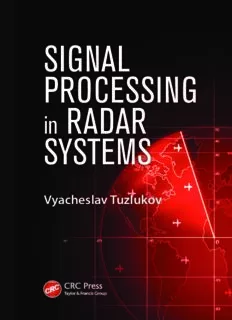
Signal Processing in Radar Systems PDF
Preview Signal Processing in Radar Systems
Electrical Engineering TUZLUKOV S SI G NAL SIGNAL PROCESSING I G in RADAR SYSTEMS N A PRO CESSI N G L An essential task in radar systems is to find an appropriate solution to the P problems related to robust signal processing and the definition of signal param- R eters. Signal Processing in Radar Systems addresses robust signal process- O ing problems in complex radar systems and digital signal processing subsystems. It also tackles the important issue of defining signal parameters. C RADAR in E The book presents problems related to traditional methods of synthesis and S analysis of the main digital signal processing operations. It also examines prob- lems related to modern methods of robust signal processing in noise, with a focus S on the generalized approach to signal processing in noise under coherent filtering. I SYSTEMS N In addition, the book puts forth a new problem statement and new methods to solve problems of adaptation and control by functioning processes. Taking a G systems approach to designing complex radar systems, it offers readers guidance in solving optimization problems. i n Organized into three parts, the book first discusses the main design principles of R the modern robust digital signal processing algorithms used in complex radar A systems. The second part covers the main principles of computer system design for these algorithms and provides real-world examples of systems. The third part D deals with experimental measurements of the main statistical parameters of A Vyacheslav Tuzlukov stochastic processes. It also defines their estimations for robust signal processing R in complex radar systems. S Written by an internationally recognized professor and expert in signal process- Y ing, this book summarizes investigations carried out over the past 30 years. It supplies practitioners, researchers, and students with general principles for S designing the robust digital signal processing algorithms employed by complex T radar systems. E M S K11252 SIGNAL PROCESSING RADAR in SYSTEMS SIGNAL PROCESSING RADAR in SYSTEMS Vyacheslav Tuzlukov Boca Raton London New York CRC Press is an imprint of the Taylor & Francis Group, an informa business MATLAB® and Simulink® are trademarks of The MathWorks, Inc. and are used with permission. The MathWorks does not warrant the accuracy of the text or exercises in this book. This book’s use or discussion of MATLAB® and Simulink® software or related products does not constitute endorsement or sponsorship by The MathWorks of a particular peda- gogical approach or particular use of the MATLAB® and Simulink® software. CRC Press Taylor & Francis Group 6000 Broken Sound Parkway NW, Suite 300 Boca Raton, FL 33487-2742 © 2013 by Taylor & Francis Group, LLC CRC Press is an imprint of Taylor & Francis Group, an Informa business No claim to original U.S. Government works Version Date: 20120629 International Standard Book Number-13: 978-1-4398-2608-9 (eBook - PDF) This book contains information obtained from authentic and highly regarded sources. Reasonable efforts have been made to publish reliable data and information, but the author and publisher cannot assume responsibility for the valid- ity of all materials or the consequences of their use. The authors and publishers have attempted to trace the copyright holders of all material reproduced in this publication and apologize to copyright holders if permission to publish in this form has not been obtained. If any copyright material has not been acknowledged please write and let us know so we may rectify in any future reprint. Except as permitted under U.S. Copyright Law, no part of this book may be reprinted, reproduced, transmitted, or uti- lized in any form by any electronic, mechanical, or other means, now known or hereafter invented, including photocopy- ing, microfilming, and recording, or in any information storage or retrieval system, without written permission from the publishers. For permission to photocopy or use material electronically from this work, please access www.copyright.com (http:// www.copyright.com/) or contact the Copyright Clearance Center, Inc. (CCC), 222 Rosewood Drive, Danvers, MA 01923, 978-750-8400. CCC is a not-for-profit organization that provides licenses and registration for a variety of users. For organizations that have been granted a photocopy license by the CCC, a separate system of payment has been arranged. Trademark Notice: Product or corporate names may be trademarks or registered trademarks, and are used only for identification and explanation without intent to infringe. Visit the Taylor & Francis Web site at http://www.taylorandfrancis.com and the CRC Press Web site at http://www.crcpress.com To the undying memory of Dr. Peter Tuzlukov, my dear father and teacher Contents Preface..............................................................................................................................................xv Author..............................................................................................................................................xix Introduction......................................................................................................................................xxi Part I Design of radar Digital Signal Processing and Control algorithms Chapter 1 Principles.of.Systems.Approach.to.Design.Complex.Radar.Systems...........................3 1.1. Methodology.of.Systems.Approach...................................................................3 1.2. Main.Requirements.of.Complex.Radar.Systems...............................................6 1.3. Problems.of.System.Design.for.Automated.Complex.Radar.Systems.............13 1.4. Radar.Signal.Processing.System.as.an.Object.of.Design.................................15 1.5. Summary.and.Discussion.................................................................................21 References...................................................................................................................23 Chapter 2 Signal.Processing.by.Digital.Generalized.Detector.in.Complex.Radar.Systems.......25 2.1. Analog-to-Digital.Signal.Conversion:.Main.Principles...................................25 2.1.1. Sampling.Process................................................................................25 2.1.2. Quantization.and.Signal.Sampling.Conversion..................................29 2.1.3. Analog-to-Digital.Conversion:.Design.Principles.and.Main. Parameters...........................................................................................30 2.1.3.1. Sampling.and.Quantization.Errors......................................30 2.1.3.2. Reliability............................................................................32 2.2. Digital.Generalized.Detector.for.Coherent.Impulse.Signals...........................32 2.2.1. Matched.Filter.....................................................................................32 2.2.2. Generalized.Detector..........................................................................34 2.2.3. Digital.Generalized.Detector..............................................................36 2.3. Convolution.in.Time.Domain...........................................................................39 2.4. Convolution.in.Frequency.Domain..................................................................47 2.5. Examples.of.Some.DGD.Types........................................................................52 2.6. Summary.and.Discussion.................................................................................53 References...................................................................................................................55 Chapter 3 Digital.Interperiod.Signal.Processing.Algorithms......................................................57 3.1. Digital.Moving-Target.Indication.Algorithms..................................................57 3.1.1. Principles.of.Construction.and.Efficiency.Indices..............................57 3.1.2. Digital.Rejector.Filters........................................................................60 3.1.3. Digital.Moving-Target.Indicator.in.Radar.System.with.Variable. Pulse.Repetition.Frequency.................................................................66 3.1.4. Adaptation.in.Digital.Moving-Target.Indicators.................................67 vii viii Contents 3.2. DGD.for.Coherent.Impulse.Signals.with.Known.Parameters..........................69 3.2.1. Initial.Conditions.................................................................................69 3.2.2. DGD.for.Target.Return.Pulse.Train....................................................72 3.2.3. DGD.for.Binary.Quantized.Target.Return.Pulse.Train......................74 3.2.4. DGD.Based.on.Methods.of.Sequential.Analysis................................75 3.2.5. Software.DGD.for.Binary.Quantized.Target.Return.Pulse.Train.......81 3.3. DGD.for.Coherent.Impulse.Signals.with.Unknown.Parameters......................82 3.3.1. Problem.Statements.of.Digital.Detector.Synthesis.............................82 3.3.2. Adaptive.DGD.....................................................................................84 3.3.3. Nonparametric.DGD...........................................................................87 3.3.3.1. Sign-Nonparametric.DGD...................................................88 3.3.3.2. Rank-Nonparametric.DGD..................................................89 3.3.4. Adaptive-Nonparametric.DGD...........................................................91 3.4. Digital.Measurers.of.Target.Return.Signal.Parameters...................................93 3.4.1. Digital.Measurer.of.Target.Range.......................................................94 3.4.2. .Algorithms.of.Angular.Coordinate.Estimation.under.Uniform. Radar.Antenna.Scanning....................................................................95 3.4.3. .Algorithms.of.Angular.Coordinate.Estimation.under.Discrete. Radar.Antenna.Scanning..................................................................100 3.4.4. Doppler.Frequency.Measurer............................................................103 3.5. .Complex.Generalized.Algorithms.of.Digital.Interperiod.Signal.Processing......105 3.6. Summary.and.Discussion...............................................................................108 References.................................................................................................................111 Chapter 4 Algorithms.of.Target.Range.Track.Detection.and.Tracking.....................................115 4.1. Main.Stages.and.Signal.Reprocessing.Operations.........................................117 4.1.1. Target.Pip.Gating:.Shape.Selection.and.Dimensions.of.Gates.........119 4.1.2. Algorithm.of.Target.Pip.Indication.by.Minimal.Deviation. from Gate.Center...............................................................................122 4.1.3. Target.Pip.Distribution.and.Binding.within.Overlapping.Gates.......125 4.2. Target.Range.Track.Detection.Using.Surveillance.Radar.Data.....................128 4.2.1. Main.Operations.under.Target.Range.Track.Detection....................128 4.2.2. .Statistical.Analysis.of.“2m.+ 1/n”.Algorithms.under.False. Target.Range.Track.Detection...........................................................129 4.2.3. .Statistical.Analysis.of.“2m.+.l/n”.Algorithms.under True.Target. Range.Track.Detection......................................................................135 4.3. Target.Range.Tracking.Using.Surveillance.Radar.Data................................138 4.3.1. Target.Range.Autotracking.Algorithm.............................................138 4.3.2. United.Algorithm.of.Detection.and.Target.Range.Tracking.............142 4.4. Summary.and.Discussion...............................................................................143 References.................................................................................................................146 Chapter 5 Filtering.and.Extrapolation.of.Target.Track.Parameters.Based.on.Radar.Measure.....149 5.1. Initial.Conditions............................................................................................150 5.2. Process.Representation.in.Filtering.Subsystems............................................150 5.2.1. Target.Track.Model...........................................................................150 5.2.2. Measuring.Process.Model.................................................................153 5.3. .Statistical.Approach.to.Solution.of.Filtering.Problems.of.Stochastic. (Unknown).Parameters...................................................................................155
Description: